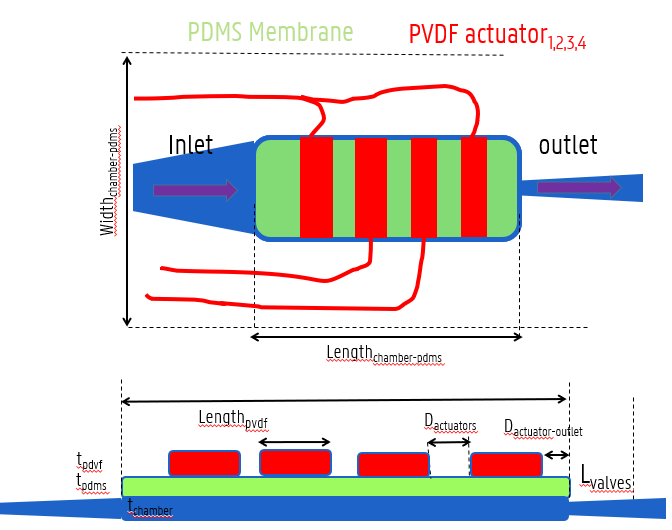Doelstelling:
Aim of the thesis
In this thesis, the student will simulate the 3D Micropump performance with COMSOL Multiphysics.
The micropump (Fig 1) will be modelled using a novel piezoelectric material as the actuator (PVDF-TrFE). Furthermore, PDMS (an elastic polymer) will be used to simulate a valveless configuration [3], the channel compartment and the housing. Currently, the design of a single chamber with multiple
actuators has been simulated (Fig. 1). However, a single chamber micropump is not able to provide the desired performances to overcome the lymphatic blockage.

Figure 1. Design of the single chamber multiactuator micropump. Blue: the fluid compartment; green: the PDMS membarne and in red the piezoelectric actuators. Approprtiate sequential activations pumps the liquid from left to right.
An effective method to obtain a desirable flow rate and back pressure without increasing the voltage is to construct multi-chamber pumps. Multi-chamber can be build either in parallel or serial connections (Fig. 2) [4].

Figure 2. (a) Single chamber configuration with only one piezoelectric actuator; (b) Multi-chamber parallel configuration with two piezoelectric actuators. Adapted from Azarbadegan et al.[5] (c) Multi-chamber configuration in a serial configuration, adapted from Liu et al.[6]
The tasks of the student would include:
- Conducting a literature research on the lymphatic system, its main pathologies and current approaches to treat lymphedema and especially on the state of the art of micropumps.
- Investigate suitable configurations to enhance the performances and design a first multi-chamber pump with single / multi actuators using Comsol Multiphysics simulations.
A working prototype of a single chamber micropump will be available by September 2021. The student will have the chance to contribute to the experimental validation and performance assessment of the prototype.